
About UsThe Numismatic Bibliomania Society is a non-profit organization promoting numismatic literature. For more information please see our web site at coinbooks.org SubscriptionsThose wishing to become new E-Sylum subscribers (or wishing to Unsubscribe) can go to the following web page link MembershipThere is a membership application available on the web site Membership Application To join, print the application and return it with your check to the address printed on the application. Membership is only $15 to addresses in the U.S., $20 for First Class mail, and $25 elsewhere. For those without web access, write to: David M. Sundman, Secretary/TreasurerNumismatic Bibliomania
Society AsylumFor Asylum mailing address changes and other membership questions, contact David at this email address: dsundman@LittletonCoin.com SubmissionsTo submit items for publication in The E-Sylum, just Reply to this message, or write to the Editor at this address: whomren@coinlibrary.com
BUY THE BOOK BEFORE THE COINYou won't regret it! |
- WAYNE'S WORDS: THE E-SYLUM MAY 17, 2009
- NUMISMATIC LITERATURE SALE CALENDAR FEATURE ADDED TO THE E-SYLUM
- BOOK REVIEW: HEY! MISTER HORN BLOWER
- WALTER BREEN’S ENCYCLOPEDIA OFFLINE
- THE SMITHSONIAN'S NEW NUMISMATIC EXHIBIT: STORIES ON MONEY
- MICHAEL REED ANSWERS DICK JOHNSON'S SALATHIEL ELLIS CAMEO QUERY
- BIBLIOPHILE ON THE FRANKLIN MINT MEDAL?
- QUERY: THE SPANISH COLONIAL MINT OF ANTIGUA GUATEMALA
- QUERY: WASHINGTON D.C. COPYRIGHT OFFICE RESEARCH HELP SOUGHT
- MORE ON HANS HOLZER
- MORE ON THE JOHN J. FORD COLLECTION
- MISCELLENEOUS E-SYLUM TOPICS
- SELECTED LOTS FROM THE JUNE 4, 2009 FANNING NUMISMATIC LITERATURE SALE
- SELECTED LOTS FROM THE JUNE 11, 2009 KOLBE NUMISMATIC LITERATURE SALE
- MORE ON THE AMAZON KINDLE BOOK READER
- U.S. MINT TO PRODUCE FEWER COINS AS ECONOMY SLOWS
- HOW TO MAKE YOUR MONEY MULTIPLY
- FEATURED WEB SITE: DON EVERHART
WAYNE'S WORDS: THE E-SYLUM MAY 17, 2009
 Among our recent subscribers are Brian Silliman, Tony Hine, And M. J. Clark. We now have 1,227 subscribers.
Among our recent subscribers are Brian Silliman, Tony Hine, And M. J. Clark. We now have 1,227 subscribers. Well, here's hoping this issue arrives in better shape than the last two. Our email provider traced the problem to an upgrade on their end. Many thanks to the E-Sylum subscribers who kept me posted on the problems and participated in testing. We're still getting reports of text-only issues getting truncated prematurely, but the HTML version seems to be back to normal again.
This week we open with a minor update to The E-Sylum format, a review of Gene Hessler's new autobiography, a setback to the online Breen Encyclopedia, and word of a new exhibit from the National Numismatic Collection in Washington, D.C. Other topics include Salathiel Ellis, Hans Holzer, and accounts of the John J. Ford numismatic holdings beyond the recent Stack's sales.
For more on the species numismaticus bibliognost, read on. Have a great week, everyone!
Wayne Homren
Numismatic Bibliomania Society
NUMISMATIC LITERATURE SALE CALENDAR FEATURE ADDED TO THE E-SYLUM
Len Augsburger writes:Well, I'd been thinking about this as well, and added a section to the right-hand section of the HTML version of The E-Sylum. Readers who view their issue this way (or on our web site) should see the list to the right of this item. Dealers are encouraged to send me an update as soon as each sale is scheduled.
BOOK REVIEW: HEY! MISTER HORN BLOWER
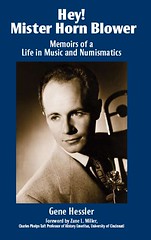 Gene Hessler is well known to numismatic bibliophiles as a top researcher of worldwide paper currency and other printed securities, particularly with reference to the artists and engravers who created these pieces. He’s written several books on the subject. Many people in the hobby also know that he was formerly a professional musician, though the details of his career were never fully explored until now. Gene has written his memoirs detailing the two careers that have occupied his lifetime, and this was a book I was quite looking forward to reading.
Gene Hessler is well known to numismatic bibliophiles as a top researcher of worldwide paper currency and other printed securities, particularly with reference to the artists and engravers who created these pieces. He’s written several books on the subject. Many people in the hobby also know that he was formerly a professional musician, though the details of his career were never fully explored until now. Gene has written his memoirs detailing the two careers that have occupied his lifetime, and this was a book I was quite looking forward to reading.The book opens with a foreword by Zane L. Miller, Charles Phelps Taft Professor of History Emeritus, University of Cincinnati. Gene then tells of his childhood in a suburb of Cincinnati and his discovery of music. Beginning with the banjo, an instrument he later relates was the subject of much derision among fellow jazz musicians, he progressed to guitar and, ultimately, trombone. This became his primary tool of the trade in adulthood, seeing him through a career that began playing popular tunes for local dances.
As he realized that other vocations were less appealing than the life of a full time musician, Gene formalized his studies in the field, culminating in his receiving a Masters degree in the 1950s.
Along the way, he played with numerous bands during the declining years of the popular big bands, learning to appreciate the new sounds of the be bop and free form period. Gene played with many famous figures in the jazz field, including Cannonball Adderly, Billy May, Woody Herman and Doc Severinsen. Other names are less familiar in the popular culture, but they will bring a smile to those in the know.
Leaving Harlem’s Apollo Theater late one night following a performance with Buddy Rich, Gene was greeted by a professional lady who furnished him with the main title of his book in an encounter that ended unsuccessfully for her.
Not content to be merely a jazz man, Gene worked in Broadway pit orchestras, symphonies, touring bands and other venues not usually associated with the jazz field. As a musician, his experiences were remarkably broad. I was surprised by just how freely he and his fellow professionals moved from one gig to another, filling in for each other on a moment’s notice in any capacity required.
Gene developed a reputation as an excellent sight reader, a musician who could perform a piece he’d never seen before and do it satisfactorily on the first take. So many pro musicians sought to play whichever job seemed most appealing at any given time that this ability to either be or locate a substitute served him quite well and provided him with a very broad resume.
Never a childhood collector of coins, Gene discovered this activity quite casually in the early 1960s. His interest in first coins and then paper money received a big boost in 1964 when he toured Africa as part of a band assembled by the U. S. State Department, which was seeking goodwill among the many newly-independent nations of that region. Through a fellow musician he learned of Lester Merkin, himself a former professional musician and by the late 1960s a prominent dealer in coins and notes.
It was through Lester that he learned of an opening for curator of the Chase Manhattan Bank Money Museum. At that time beards were still associated with bohemians, and Gene’s whiskers nearly cost him the job, but he overcame this obstacle and was hired for the position. He managed to arrange his hours so as to continue working some nights as a musician in Broadway shows, as well as being a regular in the house orchestra at Radio City Music Hall, again calling on substitutes as needed.
The Chase position ended shortly after the bank closed its museum in 1975, Gene staying long enough to conclude its affairs, leaving in 1977. During his time there he was called upon a number of times to appear on television shows regarding whatever numismatic story had made the mainstream media at the time. He also managed to stump the panel on “What’s My Line?” It’s likely that none of the celebrity panelists even knew the word "numismatist".
The museum curatorship also provided a wonderful opportunity to perform research utilizing its collection, and this further prompted Gene to continue his research at the Smithsonian and the National Archives in Washington, DC. This work resulted in the series of books carrying his name, my favorite of which is The Engraver’s Line.
Gene’s many experiences in the numismatic field brought him into contact with a wide range of familiar personalities, some of whom have passed, while others remain quite active. A few readers of The E-Sylum will find their names mentioned in this memoir.
As the 1970s gave way to the ‘80s, Gene continued to work as a professional musician, but to a gradually lessening degree. By the end of the decade he had given up paid performances entirely, though he still enjoyed playing for personal satisfaction with fellow musicians who relished the opportunity to do as they pleased musically. Gene’s accomplishments in numismatics are well enough known to E-Sylum readers that they don’t need repeating here, but he remains active as a researcher and educator.
Gene’s memoirs betray the disappointment felt by many jazz musicians that the art itself and the people who crafted it are not held in higher esteem by Americans. This very American music form strayed from the popular during the late 1940s and early 1950s, becoming a style appreciated more by the players than by the audiences, though there remained a small following of hipsters who understood what the musicians were doing. This is my observation, though it seems to echo what Gene expresses in his book.
There’s no real bitterness in his writing, however, merely a reflection of what should be. He is clearly not a fan of the more popular music of recent decades, as the home-made aspect of it is anathema to someone who has studied music formally and has played all its most complex variations.
I’d say that Hey! Mister Horn Blower is about 70% music and 30% numismatics, reflecting the relative roles these fields have played in Gene’s life. I enjoyed both aspects, the music stories more so as they were less familiar to me. As one who played trombone in school myself but never progressed beyond mediocrity, I was pleased to read about the experiences of a professional who reached the top of his form and made the most of it.
This is a very easy read and a quite enjoyable one. I highly recommend it to readers of The E-Sylum. Gene’s book is available directly from him at $25 postpaid for softcover and $35 postpaid for the hardcover. I chose the latter, and they are in limited supply. Gene requests that buyers specify whether they desire an unsigned book, a simple signature or a personalization. Orders should be made payable to Gene Hessler and sent to him at POB 31144, Cincinnati, OH 45231.
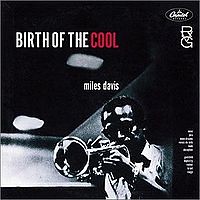
And where else can you read in the same book about adventures in such far away nooks and crannies as Mogadishu, Somalia and McKeesport, PA? Even his off hours are fascinating, including many visits to Birdland to hear the likes of Harry Belafonte, Charlie Parker and Charlie Mingus. Or hanging with friends who played in The Tonight Show band while the group was entertained by Groucho Marx?
I've been privileged to have known Gene for many years, and I'm very glad he took the time to write this great book - I recommend it to everyone with even a passing interest in either music or numismatics. It includes a very thorough appendix listing all of Gene's published works on numismatics. -Editor
WALTER BREEN’S ENCYCLOPEDIA OFFLINE
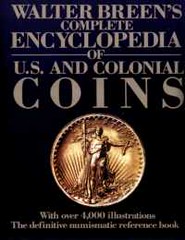 Although I had spoken to the Breen online site Webmaster, Tom Pilitowski, to verify that he did have the right to publish the book, which he said he did, the numerous questions I received made me do a double take. I contacted the current owner of the book's copyright, Bowers and Merena, and spoke to the president of the company, Steve Deeds. Mr. Deeds also verified that Pilitowski had permission to put the book online. I was satisfied with this, because if the president of the company can't speak for the entity he controls, who can?
Although I had spoken to the Breen online site Webmaster, Tom Pilitowski, to verify that he did have the right to publish the book, which he said he did, the numerous questions I received made me do a double take. I contacted the current owner of the book's copyright, Bowers and Merena, and spoke to the president of the company, Steve Deeds. Mr. Deeds also verified that Pilitowski had permission to put the book online. I was satisfied with this, because if the president of the company can't speak for the entity he controls, who can?This is where the story starts getting curious. Several days after I had spoken to Deeds, Pilitowski contacts me to tell me that he has been asked to take the Breen site down. Even though Deeds had clearly given permission to Pilitowski to publish the book, and even though I carefully confirmed this fact, Bowers and Merena's parent company, Escala, stepped into the picture and requested the site be removed.
When I spoke to Deeds again about this, he had subtly backed away from his position that he gave permission, claiming that he wasn't fully cognizant of the fact that the book was being published in its entirety, word for word, online. Deeds said that he assumed Pilitowski meant to use excerpts of the book in conjunction with Pilitowski's U.S. Rare Coin Investments business. He said that if he'd known Pilitowski had meant to publish the entire thing, he never would have agreed.
The curious part of all this is why Escala was suddenly drawn into the picture.
It has become obvious that some person, who seems to have some kind of grudge against either Pilitowski or coin collectors in general, has conducted an organized campaign to get the book taken offline! Several emails were sent to Deeds, and when that that didn't seem to get the job done, the same person saw that Deeds' superior at Escala, Greg Roberts, began receiving the emails. The emails were of the tattle-tale variety, as if someone was hoping to have the Breen site taken down because Pilitowski had done something wrong.
Why anybody would want to deprive coin collectors of this wonderful resource is beyond me. Like all business worlds, the coin world has its share of politics and infighting, and my best guess is that this was the motivation behind the emails.
Efforts are underway right now to restore the site, which was reluctantly taken offline on Sunday. Bowers and Merena is working on a revised edition of the Breen book...
To read the complete blog post, see: Breen Book Online Controversy (http://coins.about.com/b/2009/05/12/
breen-book-online-controversy.htm)
To read the earlier E-Sylum article, see: WALTER BREEN’S ENCYCLOPEDIA AVAILABLE ONLINE (http://www.coinbooks.org/esylum_v12n18a10.html)
To (try to) view the Breen Encyclopedia online (feel lucky?), see: www.breenencyclopedia.com
THE BOOK BAZARRE
THE SMITHSONIAN'S NEW NUMISMATIC EXHIBIT: STORIES ON MONEY
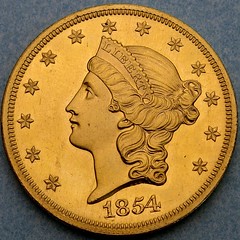 A new exhibition at the National Museum of American History invites visitors to explore the development and meaning behind American coinage and currency. “Stories on Money” demonstrates the interplay among people, money and history, from the earliest times to the present day. The display of coins and other related objects will open June 12 in a new first-floor gallery.
A new exhibition at the National Museum of American History invites visitors to explore the development and meaning behind American coinage and currency. “Stories on Money” demonstrates the interplay among people, money and history, from the earliest times to the present day. The display of coins and other related objects will open June 12 in a new first-floor gallery. “Stories on Money” explores the museum’s vast numismatic collections from seven vantage points. The main section shows what money looked like in Colonial America and at pivotal times, including the Gold Rush, Great Depression and in the current era. Visitors will compare the coin designs of the 19th century with those produced during the renaissance of American coinage in the early 20th century. The section called “The Power of Liberty,” presents an array of coins from the United States and the world depicting Liberty, the feminine personification of freedom; coins with real and mythological women are also featured.
“American currency is a reflection and a record of our history,” said Brent D. Glass, director of the museum. “This display illuminates history in fresh and unexpected ways and will allow visitors to think of how money tells stories about different historical periods.”
“Stories on Money” was made possible through the generosity of the Numismatic Guaranty Corporation of America, Numismatic Conservation Services and Monaco Rare Coins.
“Having this wonderful space at the museum is very meaningful to the entire community of numismatists, and we are very proud to be a part of it. ‘Stories on Money’ is an especially fitting exhibition since it illustrates the close interplay between coins as objects and the personal history of their use,” said Mark Salzberg, chairman of sponsoring organizations Numismatic Guaranty Corporation and Numismatic Conservation Services.
“The ‘Stories on Money’ exhibition explores the importance of our country’s sovereignty, heritage and financial independence,” said Adam Crum, president of Monaco Rare Coins. “The beauty of the coins speaks for itself, but the history witnessed by these miniature objects is often epic.”
The exhibition draws from the museum’s National Numismatic Collection, which consists of more than 1.5 million objects, including coins, medals and paper currency and preserves the role of money in economic history. Featured objects include a colonial Massachusetts shilling from 1690—the first paper money in the Western hemisphere, the unique 1849 $20 gold coin and a clam shell used as currency during the Great Depression.
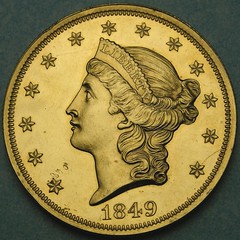
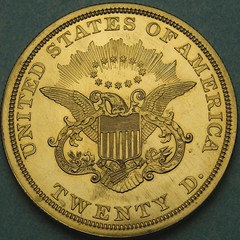
The exhibition uses objects and interactive media to immerse visitors in these stories on money, including an opportunity to view enlarged images and delve further into numismatic history. In “A penny for your thoughts?” visitors can cast their opinion about the future of the most-produced coin in the world.
Two books based on the National Numismatic Collection have been published in conjunction with the exhibition. Exhibition curator Richard Doty’s “America’s Money, America’s Story” and “The Encyclopedia of U.S. Gold Coins” by visiting researcher Jeff Garrett substantiate the scholastic value of the National Numismatic Collection. Doty and Garrett, a lifelong coin collector, have spent their careers working in numismatics and have written several books on the subject.
To learn more about the museum, check http://americanhistory.si.edu.
To read the complete article, see: Money Talks at the Smithsonian’s National Museum of American History (http://7thspace.com/headlines/309038/money_talks_at
_the_smithsonians_national_museum_of_american_history.html)
MICHAEL REED ANSWERS DICK JOHNSON'S SALATHIEL ELLIS CAMEO QUERY
Michael responded. "I saw your query regarding Salathiel Ellis cameos," he wrote. "and immediately thought of the Preston King (1806-1865) memorial stone found in the Ogdensburg Cemetery in Ogdensburg, New York. It contains a wonderful marble cameo of Preston by Ellis. I've attached an image for your reference."
I would have never come across such an image or monument in all my searching and researching. Michael had been researching artist Sally James Farnham and had come across this tombstone on a visit to that cemetery. Isn't that serendipity?
It also proves the depth of knowledge and wide experience of E-Sylum readers. Bless you all.
Now since Michael responded to my request, I would like to give something back to the field in return. If you have any question in three areas of my expertise, please send on your inquiry. I will attempt to answer any question on: One, American medals and medallists of the 19th and 20th century [no appraisals, however]. Second is coin and medal technology of a similar time period -- how something was made, for instance.
The third area is future coins. This is tough to research, obviously, but I have given it a lot of thought. It is more than speculation, it is based on current trends and emerging technology. Project these into the future and you have some insight what future coins will be.
And if I can answer your question, thank Michael Reed. He answered mine. Thanks again Michael! Contact anytime: dick.johnson@snet.net
BIBLIOPHILE ON THE FRANKLIN MINT MEDAL?
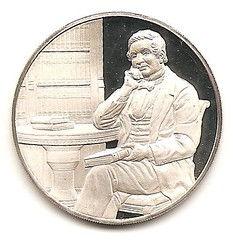 Responding to Pete Smith's query about the person depicted on this Franklin Mint medal, Larry Gaye writes:
Responding to Pete Smith's query about the person depicted on this Franklin Mint medal, Larry Gaye writes: David Gladfelter writes:
Under auspices of the Postmasters of America, the Franklin Mint began striking medals in 1971 in conjunction with the issuance of commemorative stamps by the United States Postal Service. See “FM Joins Postmasters in Honoring New U.S. Postal Service,” Franklin Mint Almanac, August 1971, page 12.
On October 10, 1974, the USPS issued an “American Folklore: Sleepy Hollow” stamp. Pete’s medal was used on the medallic first day cover for that stamp. The first day covers were mailed from the North Tarrytown, N. Y. post office. The medal was designed by sculptor James Ferrell. It was described as a “limited edition proof,” but the mintage was not so limited – 16,582, according to Chet Krause’s Guidebook of Franklin Mint Issues, 1980 edition. The medallic covers were sold by annual subscription and the issue price was $15.75. Pete’s medal, sans cover, is probably not worth much over bullion value.
The Legend of Sleepy Hollow was written by Washington Irving. Its main character is one Ichabod Crane.
To read the previous E-Sylum article, see: QUERY: NAME THE BIBLIOPHILE ON THIS FRANKLIN MINT MEDAL (http://www.coinbooks.org/esylum_v12n19a14.html)
QUERY: THE SPANISH COLONIAL MINT OF ANTIGUA GUATEMALA
Carlos Jara writes:- I have yet to confirm any minor gold coins of Philip V
- I have yet to confirm dates of 8 Escudos other than the ones listed by Calico´s recent book "LA ONZA".
- I would be interested in finding the whereabouts of the pillar round 8 Reales 1743 listed, plates and referenced by Prober (although this coin is probably a concoction).
QUERY: WASHINGTON D.C. COPYRIGHT OFFICE RESEARCH HELP SOUGHT
Tom and Sharone Dalrymple write:
Copyright applications should provide such things as the artist's name (by way of assignment to Metal Arts) as well as perhaps drawings or even photos. The trouble is, the older applications/records are not yet "on line" and I am living in Alaska, making the trip to D.C. a bit longer than a day's drive.
Being newly minted members of the American Numismatic Association, and new to just about every other coin club as well, we don't know yet what resources are out there. That said, it would be fantastic to have someone located physically in D.C. that could, perhaps for a fee, look up Copyrights filed by some of these older "Private Mints". Can anyone help?

MORE ON HANS HOLZER
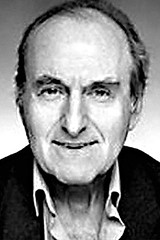 Hans Holzer, who has passed over to the other side, was a celebrated ghost hunter and author of many books about the paranormal, including Murder At Amityville (1979) - the basis for the low-budget sequel film to The Amityville Horror. Holzer described himself as an academic parapsychologist and took his calling seriously.
Hans Holzer, who has passed over to the other side, was a celebrated ghost hunter and author of many books about the paranormal, including Murder At Amityville (1979) - the basis for the low-budget sequel film to The Amityville Horror. Holzer described himself as an academic parapsychologist and took his calling seriously.He dismissed the existence of angels and regarded religions as corporations that make large profits out of scaring the hell out of their followers. He gave up celebrating Christmas after establishing "beyond a shadow of a doubt" that Jesus was born on October 3, 7BC, and stopped attending church when the minister declined his offer to contribute to a seminar on religions.
But he was firm in his belief in ghosts and was convinced that extraterrestrials abduct humans to learn about life on Earth. He believed in reincarnation and was a Wiccan high priest.
Hans Holzer, who has died aged 89, was born in Vienna, studied archaeology, ancient history and numismatics at the University of Vienna but left Austria with his family in 1938. After studying Japanese, he tried to make a living in showbusiness, writing for a short-lived comedy revue and musical.
To read the complete article, see: Writer hunted ghosts but never felt afraid (www.smh.com.au/national/obituaries/writer-hunted-ghosts-but-never-felt-afraid-20090511-b0id.html)
Ken Bressett writes:
We never really got along very well after that although our paths did cross occasionally. I missed an opportunity to meet with him in Chicago one time when we were both invited to a party for Sybil Leek, the famous English witch. The gathering was cancelled because of a winter storm (or perhaps mystical intervention) which I very much regretted, as I considered them both bizarre characters.
His book Star in the East (Harper & Row 1968) has a chapter on what he terms the oldest Christian Coins.
MORE ON THE JOHN J. FORD COLLECTION
George Fuld writes:
I began work at Bowers & Ruddy in August of 1980 after the first two of the Garrett Collection auctions. For the previous year or eighteen months, John Ford was selling material through B&R auctions to raise money for purchases at the Garrett sales. He sold any U. S. coins that he had but I was not privy to what was sold before August, 1980.
The one group that I recall was that he had a half roll or so of mint red 1853 half cents. These were sold two or three per sale for a lengthy period. After I arrived at B&R, he sold four or five groups of material but my memory is not complete on all. One large group of Nazi material was one that I cataloged. Another was a group of souvenir spoons sold about 1981. I guess I could recall the other groups but I don’t have copies of B&R auctions of this time to refresh my memory
I should mention that Ford’s Washington material (except for the medals prior to 1835) were sold in a published list by Jack Collins in 1991.
I worked for Stack’s in the period of 2004-2005 cataloging Ford’s merchant material, his large political holdings and other miscellaneous non-coin U.S. material. In all there was just over 5,000 items cataloged. The only material sold in the 21 Ford sales that I cataloged were the Hard Times tokens and his extensive struck copies collection.
The balance was never auctioned but was sold privately but I’m not at liberty to discuss this further. I can say what was generally contained in the remaining collection.
Of course his merchant tokens of the nineteenth century were outstanding and possibly the best group of material ever assembled. His western token group was remarkable. There were only a few civil war cents, mostly gleaned from the political section—he had sold his other groups of Civil War tokens some years earlier. But these few Civil War cents were all quite rare including several unlisted varieties.
His sutler tokens numbered over 250 pieces. His Indian traders tokens numbered about 40 tokens. His post traders tokens numbered about 100 pieces. His territorial tokens numbered about 125 items. There were miscellaneous medals of the nineteenth century that were unremarkable. His Canadian material consisted of less than 10 pieces (his Canadian Jetton series was sold in a Ford sale cataloged by Mike Hodder).
The most remarkable group of material was his political token and medal collection, numbering certainly over 2,500 items. His ferrotype group was exceptional but I think Weinberg’s guess of 500 pieces is a bit high. Much of the material was ex. F. C. C. Boyd and the number of tokens struck in silver was amazing.
Perhaps the most notable comment on the political collection was that little if any were actually studied and cataloged by Ford. Somehow it appeared that John had not gotten around to working on this part of his collection, unlike his other studies on merchant pieces
Certainly some day in the future, Ford’s exonumia material will come on the market and the full depth of his collection will be realized.
Paul Bosco writes:
Ford consigned huge quantities of Colonial paper money, which he possessed by the ream. I don't know what else he may have consigned. He was a boon to NASCA for another reason, steering the holdings of Werner Amelingmeier to them. Ford sold Amelingmeier much of the foreign coins in the Wayte Raymond estate, with the proviso that it not be resold during Olga Raymond's lifetime. I believe he paid $40,000 (c.1954) for material that realized a bit over $1 million (c. 1977-83) - a normal appreciation for such material in that era.
I don't know what else Ford may have consigned NASCA, if anything, but I expect John dropped off the occasional consignment on the way to the supermarket. Melnick once melted some controversial Spanish-American gold bars, which I believe were consigned and whose reserves were met, post-auction, by a rise in bullion prices (1979??) They may not have been consigned by Ford but could have had a Ford provenance.
Marty Gengergke once told me the four best collections of Fractional Currency were his, Jackson Storm's, I think Milton Friedberg's and Ford's, but Marty added "if you can call Ford's a collection and not just an accumulation." Ford's earlier start enabled him to collect by the shoeboxfull what others collected over decades of concentrated effort.
Once Ford stopped in at the NASCA office, c.1980, carrying a large silver disk, which I believe he said he got from Boyd. It was a hand-engraved medal, 1793, for a ship stopping in Australia, #1 in Carlisle's book on Australian medals. He was about to consign it to Spink/Australia, having been told they would get $25,000 for it. It's like their Brasher Doubloon.
Ford consigned his cut and counterstamped coins to Baldwin's, whom I believe he liked and respected and considered peers. I believe he was genuinely fond of this series. This was a named, single-owner sale.
C.1984, there was a Bowers & Merena sale (I think Van Ormer is one of the names on the cover). It included a few lots of Lafayette medals. The majority, I think, were bought by Ford with me as the underbidder. Later, outside the auction room, Ford told me he bought them in (as a floor bidder): "I guess the market isn't ready for them yet." I think they have not reappeared.
I expect there was considerable Ford material in Stack's and Coin Galleries auctions other than the named sales. I suspect many of the Philippines coins in one of Stack's post-NY International floor auctions were ex-Ford.
Ford sold privately, to Don Partrick in particular, which is no secret. When Don won the Confederate Half Dollar, and I congratulated him on his bargain, he said to me, "For once I got Ford," but I did not think he felt the one purchase drew him even.
There was a sale of numismatic literature at Swann Galleries, in the days before George Kolbe was a player, and when coin auction houses rarely auctioned books. I think it was a couple days after the 1976 American Numismatic Association convention in New York City. I believe it was known to many in the room that all or most came from Ford, and that he was a "contributing cataloger", or lead researcher, if you will. After some of the lots, the auctioneer offered to sell the underbidder a duplicate, lowering the winning bid to match. The consignor was anonymous but if memory serves, there were Boyd pedigrees.
Ford collected almost his whole life, but by the mid-'70s he had left New Netherlands for (semi-)retirement. I expect that he mainly subsisted by removing the dust from decades-old purchases, reaping profit and appreciation. Since no one could know all that he owned, who could have noticed if he divested, here and there, a piece or a small group? He was no recluse, but he did not seek publicity -- the one trait he had in common with Eric Newman.
Ford's impact on 20th century American Numismatics, properly weighed, may rival that of B. Max Mehl. I realize my reminiscences may lead some younger numismatists to think I am an old-timer. (Bosh!) By happenstance, I did have some contact with Ford and some who knew him well, but it would be nice if others spilled the beans on "JJF" - guys like Harvey Stack, Steve Tanenbaum, Dave Bowers, John Adams, Mike Hodder: a Ford symposium with some or all of them would till a lot of numismatic soil. (And perhaps fertilize it a bit, too.)
At present, the most definitive word on Ford, as a dealer, numismatist and persona, is not in the XXI Stack's auction catalogs, but rather "How the West Was Faked" by the redoubtable Mr. Kleeberg. Ford was not an angel, and those who praise him do so with asterisk, but he did enough good that it should not all be interred with his bones.
David Gladfelter adds:
Many thanks to everyone for providing this background. The extent of the Ford holdings is nothing less than stunning.
QUICK QUIZ: What is Werner Amelingmeier's connection to numismatic literature? -Editor
MISCELLENEOUS E-SYLUM TOPICS
Adrián González Salinas notes that Amazon.com has a nice sale price for the upcoming new edition of Jim Noles' book, A Pocketful of History: Four Hundred Years of America-One State Quarter at a Time. He writes:
Regarding Joe Boling's question about Kansas Paper Money: An Illustrated History, 1854-1935, Ron Benice writes:
Regarding Paul Bosco's note on the Yoachum Dollar, Tom DeLorey writes:
David Fanning writes:
Actually, the revision of Mease was published in 1834. It's dated 1832 in the text, but it's in the 1834 "Collections." I have a copy of it in the May issue of my fixed price list The Bookshelf, which goes to the printer today.
THE BOOK BAZARRE
SELECTED LOTS FROM THE JUNE 4, 2009 FANNING NUMISMATIC LITERATURE SALE
Lot 223 . [Newcomer, Waldo]. Archive of photographs and photographic negatives depicting important U.S. gold and silver coins and private and territorial gold pieces from the Waldo Newcomer collection.
The Waldo Newcomer collection was one of the finest of its day, and remains an important achievement in the history of coin collecting in the U.S. In some areas (such as private and territorial gold), it was magnificent.
Unfortunately, it is also one of the most important collections of U.S. coins ever assembled for which a full catalogue was never written. No auction sale was held, no sylloge compiled: meaning that for provenance studies, the Newcomer collection is something of a black hole, with little certain information about what exactly it contained (Morgenthau and Mehl did sell some of Newcomers duplicates and world coins).
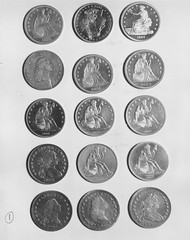
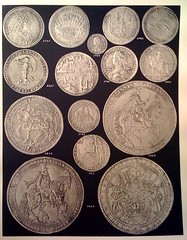
The main collection was liquidated through B. Max Mehl, who sold many of the pieces directly to Col. E.H.R. Green (hence the writing on some of these envelopes identifying the photos as being of his coins). The photographs and negatives offered here were taken for Mehl, with some bearing Ft. Worth photographer stamps.
While there have been offerings of photographs from the Newcomer collection on a couple occasions (in George Kolbe’s 1993 ANA sale and in Part II of the Champa library sales catalogued by Charles Davis, earlier in a March 1993 Money Tree sale), this may be the first time that actual photographic negatives depicting the collection have been publically offered. These were part of the B. Max Mehl estate, and were subsequently acquired by Abe Kosoff.
Lot 397 Chapman, Henry. Catalogue of the John Story Jenks Collection of Coins. Ancient, Greek, Roman and the Entire World. Early American Colonial and State Issues and United States Patterns and the Regular Issues. Philadelphia, Davis & Harvey, Dec. 7–17, 1921.
Arguably the most important American cabinet ever sold, in terms of both total coverage and quality. While other collections have been formed that exceeded the Jenks cabinet in depth, few if any rival it in breadth while maintaining a focus on outstanding condition.
Were the sale to have included only the U.S. material, it would have been an excellent sale, with exquisite early coppers, important patterns, rare private and territorial gold, and other desiderata. Indeed, most of the highest prices were from this part of the sale. Yet, the coins of the Western Hemisphere don’t even start until lot 5315. The first several thousand lots constitute a veritable atlas of numismatics.
A decadrachm of Syracuse signed by Kimon is included, as is Simon’s Petition Crown of 1663. The 42 photographic plates illustrate an incredible 1,412 lots. In addition to the catalogue’s unquestionable importance is its rarity: John W. Adams noted that “Most of the [Chapman] quarto plate editions were printed in runs of 100. Two exceptions are Siedlecki (1911) and Jenks (1921) of which only fifty and sixty were made respectively.”
Most surviving copies are well worn, due partly to the catalogue’s massive size and due partly to its being the best single-volume reference to the coins of the world for probably half a century or more.
Lot 316 Frossard, Ed. Numisma. Group of 9 numbers [as published in 8 issues] plus one supplement.
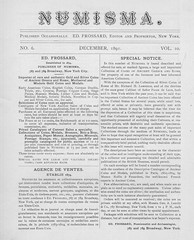 A nice group of later issues of the house organ which provides much of the basis for Frossard’s lasting reputation. Modest in appearance, with the average issue being only eight pages long, Numisma is one of the most entertaining publications ever to grace the hobby: by parts scholarly and serious, it was also back-stabbing, venomous and filled to the brim with gossip of every description, making it as much fun to read 120 years later as it must have been on its original publication (if one wasn’t on the receiving end of Frossard’s stings).
A nice group of later issues of the house organ which provides much of the basis for Frossard’s lasting reputation. Modest in appearance, with the average issue being only eight pages long, Numisma is one of the most entertaining publications ever to grace the hobby: by parts scholarly and serious, it was also back-stabbing, venomous and filled to the brim with gossip of every description, making it as much fun to read 120 years later as it must have been on its original publication (if one wasn’t on the receiving end of Frossard’s stings). What was standard journalistic fare to Frossard would probably land a publisher in court today. Part house organ, part unofficial supplement to the American Journal of Numismatics, part scandal sheet and yellow journalism, Numisma played a role in the hobby of the late 19th century that could not be compared to that of any publication today.
SELECTED LOTS FROM THE JUNE 11, 2009 KOLBE NUMISMATIC LITERATURE SALE
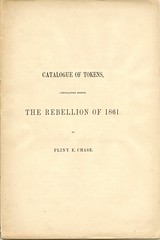 Davis 234: “No sale recorded.” A rare 1863 offprint from the Proceedings of the American Philosophical Society, appearing as an article the same year in Volume IX, pages 242-258.
Davis 234: “No sale recorded.” A rare 1863 offprint from the Proceedings of the American Philosophical Society, appearing as an article the same year in Volume IX, pages 242-258. It appears to be the second example to come to market since the August 15, 1971 Fuld Library sale (lot 679@ $12!, estimated at $50 and described as “An exceedingly rare book”) and the June 1, 2004 Ford Library sale(lot 356 @ $1,300, estimated at $1,000).
The author notes that “Collectors and others who may wish to assist in completing the collection of Token currency in the Cabinet of the American Philosophical society, may send specimens, duplicates, or descriptions of such varieties as are not mentioned in this catalogue…”
Arranged in seven different categories, namely 1) Business Cards; 2) Portraits; 3) Equestrian Statues, Fancy Heads, and Human Figures; 4) Animals; 5) Flags; 6) Miscellaneous Devices; and 7) Mottoes, Chase carefully describes 303 pieces. A remarkable contemporaneous effort to record these still underappreciated metallic memorials of the Civil War.
Pliny Earle Chase (1820-1886), was a teacher and scientist of some renown. Many of the results of his various scientific researches were published in the Proceedings of the American Philosophical Society and in European scientific journals.
Mine has one of those annoying Katen Numismatic library stickers on the inside front cover. Ya gotta love Frank, but I wish someone had taken him aside and slapped him before he started putting those in books he sold. I don't have a pedigree on my copy, so I don't know if it's the Fuld library copy or a third example. Does anyone else have one of these? -Editor
Lot 282 [Numismatic Autographs]. NUMISMATIC CORRESPONDENCE FROM M. H. BOLENDER, JOSEPH COFFIN, CHARLES FRENCH, EDWARD GANS, RICHARD PICKER, AMBROSE J. BROWN, BERNARD GIMELSON, JAMES KELLY, KENNETH W. LEE, RICHARD W./D. WAYNE JOHNSON, B. MAX MEHL, LU RIGGS, HANS M. F. SCHULMAN, PAUL S. SETZ, NORMAN STACK, L. S. WERNER, WARREN A. LAPP, O. B. WINDAU, WALTER F. WEBB, ENOCH ANDERSON, A. J. FINK, AND OTHERS.
A group of over thirty signed typewritten or handwritten letters. Also present are a few missives from philatelic dealers, several more recent letters from numismatic literature dealers, along with invoices inventories, etc. Nearly 100 pieces in all.
A most interesting collection of correspondence and other materials from famous and not-so-famous, though significant, American numismatic personalities mainly active in the mid-twentieth century.
4) several most interesting 1954-1956 letters from Richard W./D. Wayne Johnson to Dr. Charles Ferris, largely typewritten on stationery headed “Books and Bibliographic Service on Numismatics,” also with drafts of fascinating letters from Ferris to Johnson, pertaining to their shared intense interest in numismatic bibliography, featuring the results of Johnson’s early researches in the field, with commentary such as: “I had considered compiling a bibliography of all the numismatic books published in America…even though I have been lectured by Col. P. O. Sigler against it.
Col. Sigler published his book himself and lost several thousand dollars on the venture. ”the number of people interested in numismatic bibliography is quite small. (We’re rather rare birds -- species numismaticus bibliognost.)” I strongly recommend Attinelli’s book to you…I know of only seven copies in existence” [a listing follows]/etc.;
Lot 627 [Birmingham Mint]. THE MINT, BRMINGHAM, LIMITED…
THE MINT, BIRMINGHAM, LIMITED, (FORMERLY RALPH HEATON & SONS) BIRMINGHAM (ENGLAND), COINERS TO THE BRITISH, FRENCH, ITALIAN, RUSSIAN, ROUMANIAN, CHILIAN, SERVIAN AND NUMEROUS OTHER GOVERNMENTS, CONTRACT FOR THE COINAGE OF ALL KINDS OF MONEY IN GOLD, SILVER, NICKEL, COPPER, BRONZE, OR OTHER ALLOYS. THE SUPPLY OF METALS FOR COINS IN THE ROLLED STRIP, OR IN BLANKS FINISHED READY FOR THE COINING PRESS. MINT MACHINERY OF THE MOST APPROVED CONSTRUCTION, AND THE ENGRAVING AND MANUFACTURE OF DIES. ESTIMATES FURNISHED FOR ENTIRELY NEW COINAGE, OR FOR THE REFONTE AND CONVERSION OF OLD COINS INTO NEW MONEY.
Birmingham: The "Journal" Printing Offices, 31, Cannon Street, 1904. 78 pages (numbered 1-10, added leaf 10a, 11-73, followed by 3 unnumbered), errata slip tipped in, 13 very fine autotype plates of coins and medals. Original red cloth, upper cover lettered and decorated in gilt, including a depiction of the manufactory, all page edges gilt.
Ex libris Frank and Laurese Katen; ex October 6, 2001 Bergman Library Kolbe sale, lot 246. Rarely offered. An interesting collection of testimonial and other letters from coining authorities throughout the world, finely illustrated. Includes information on the products of the Birmingham Mint, including several letters and extracts from reports of C. W. Freemantle, Deputy Master of the royal Mint, London. Most interesting and useful, particularly for its superb illustrations of coins and medals from all over the world issued by the Birmingham Mint.
MORE ON THE AMAZON KINDLE BOOK READER
Donald Scarinci writes:I use Primasoft as my database software to record my collection, pictures of everything I own and, most importantly, my notes on every coin I own. If I could access that database on a lightweight, easy to turn on Kindle, how wonderful would life be? I take my laptop to shows with me and even though it is a laptop, it still adds 5 pounds to what I have to carry around. Since I collect medals, can you imagine how heavy my briefcase gets after a morning at a good coin show?
Ron Guth writes:
I commented to my wife that it would be great if one could use the Internet over this device and she promptly advised me that there is an experimental Web application already on the Kindle. I envision a Kindle-like machine that combines a color screen, electronic reader, computer, wireless Internet, email, and phone into one hand-held device.
I know, I know...Apple's iPhone already does that, but it's too small. I've heard that Apple is working on a "tablet" that will satisfy most or all of the demands of the dream machine but, in the meantime, we'll thank the Kindle for making recreational reading fun again.
Wednesday, Amazon began allowing any blogger to publish to the Kindle platform. Through a separate account set up as a Kindle Publishing for Blogs beta, authors can load their blog, identify and describe it and leave it to Amazon to convert from its RSS feed to a Kindle-friendly form factor.
Ad supported sites will lose the revenue stream generated by readers who trade the old web format for the new but the site owner will make back 30% of any subscription fee Amazon sets for the content. That assumes readers want to pay a subscription fee for content they can usually access freely through the web - which is a big assumption. (Blogs have typically been priced at $1.99 a month on Kindle).
Amazon Opens Kindle to Bloggers, But Will Readers Want to Pay? (http://seekingalpha.com/article/137628-amazon-opens-kindle-to-bloggers-but-will-readers-want-to-pay)
U.S. MINT TO PRODUCE FEWER COINS AS ECONOMY SLOWS
 The Federal Reserve was busy last year pumping $700 billion into the U.S. economy — expanding the country's money supply by nearly 10 percent. But that doesn't mean there are a lot more dollar bills circulating. In fact production statistics at the Bureau of Engraving and Printing have remained stable. And coin production has dropped precipitously.
The Federal Reserve was busy last year pumping $700 billion into the U.S. economy — expanding the country's money supply by nearly 10 percent. But that doesn't mean there are a lot more dollar bills circulating. In fact production statistics at the Bureau of Engraving and Printing have remained stable. And coin production has dropped precipitously.The U.S. Mint will make 3 billion coins in 2009 — a 70 percent decline from the 10 billion produced in 2008. It will be the smallest run in 50 years, and the retail economy is to blame.
"The Mint's mission is primarily to make coins to fulfill the demands of commerce," says Ed Moy, director of the Mint. "The demands of commerce haven't been doing too well the past six months."
Moy says there's something else going on, too — it appears more people are cashing in the coins they've saved at those counting machines near the grocery checkout counter.
"So in addition to low economic activity, there's an increased number of coins coming back into the banking system, which means that the banks need less coins from the Mint," says Moy.
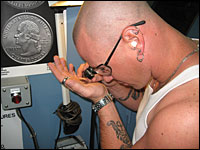 Moy says no workers will be laid off. Instead they'll catch up on routine maintenance that has been delayed and undergo extra training. Laying off such specialized workers wouldn't make sense, he says, because they'll be needed again when the economy improves.
Moy says no workers will be laid off. Instead they'll catch up on routine maintenance that has been delayed and undergo extra training. Laying off such specialized workers wouldn't make sense, he says, because they'll be needed again when the economy improves.To read the complete article, see: Mint To Press Fewer Coins As Economy Slows (http://www.npr.org/templates/story/story.php?storyId=104002765)
Alfaro's theory was that people were feeling pinched and that using coins, as opposed to dollar bills, made them feel they were spending less. He asked the worker who stocks the machine, and the answer came back that he was right. People are "kind of scrimping a little bit and digging in their car" for loose change, Alfaro says.
For Alfaro it was just a hunch, but it turns out that economists have researched the phenomenon, which they call the Denomination Effect. Priya Raghubir and Joydeep Srivastava did a series of experiments in the U.S. and China that showed people were much more willing to spend the same sum of money if they had smaller denominations instead of one large bill.
"We've done some studies with four quarters and a dollar, and we found that people were much less likely to spend the $1 note that they were given than the four quarters they were given," Raghubir says.
If we want to get consumers going again, Raghubir says, we should hand out lots of change.
Likewise, she says the IRS should stop sending tax rebates as lump sums. "You could send us travelers checks," Raghubir advises. "Send it in twenties, the way we get cash."
To read the complete article, see: Why We Spend Coins Faster Than Bills (www.npr.org/templates/story/story.php?storyId=104063298)
HOW TO MAKE YOUR MONEY MULTIPLY
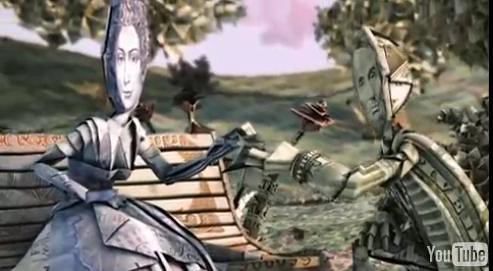
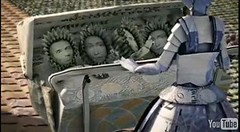 This procedure was followed by style frames in 2D to evoke the right feeling, tone and look for the film while having a special origami look in the back of our minds. After we were done creating rough animatics, we could start to fine tune our characters, as well as the different scenarios of the spot. Our final task was to blend all the scenes, camera tracks and sounds together.
This procedure was followed by style frames in 2D to evoke the right feeling, tone and look for the film while having a special origami look in the back of our minds. After we were done creating rough animatics, we could start to fine tune our characters, as well as the different scenarios of the spot. Our final task was to blend all the scenes, camera tracks and sounds together. To read the complete blog post (and view the video), see: Hilarious Ad About Dirty, Dirty Money (http://www.boingboing.net/2009/05/08/hilarious-ad-about-d.html)
FEATURED WEB SITE: DON EVERHART
This week's Featured Web Site is the Wikipedia entry for U.S. Mint coin designer Don Everhart.His coin designs are in the pockets of American citizens, and despite his late arrival to the series of the popular U.S. Statehood Quarters, he has designed and modeled three State’s unique reverse designs, modeled three others, and six U.S. commemorative coins. His portrait of President William Clinton was chosen for Clinton's second term Inaugural Medal. Among his other medal creations are six Congressional Gold Medals for the U.S. Mint, seven Society of Medalists issues, twelve calendar medals, and other models for private medal makers, as well as cast art medals.
http://en.wikipedia.org/wiki/Don_Everhart
